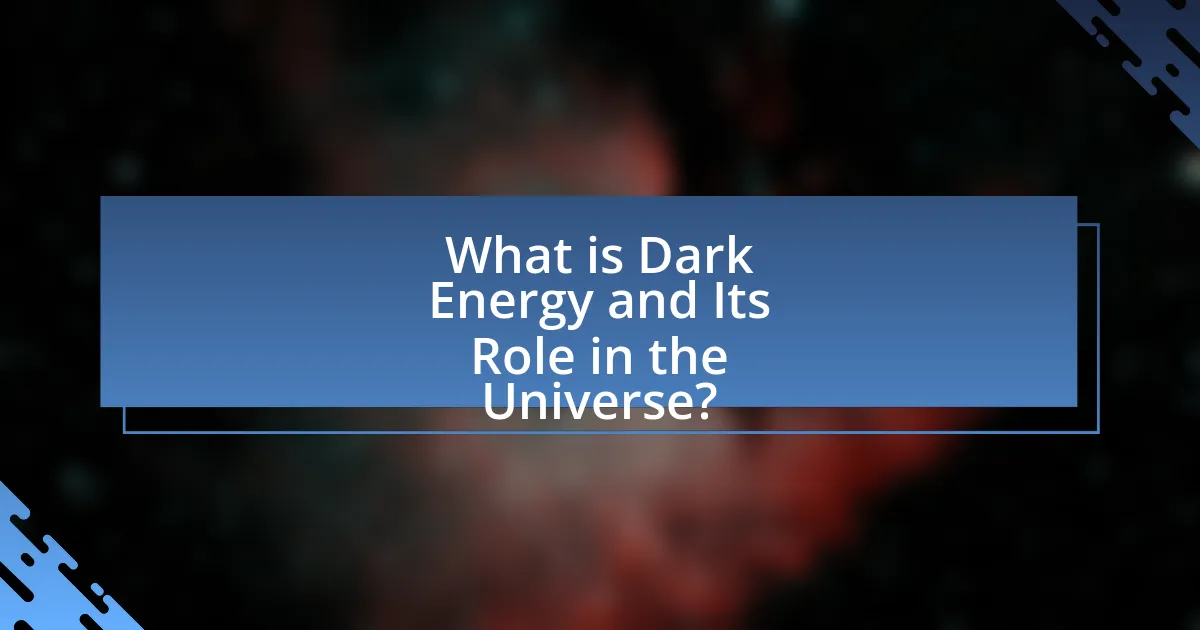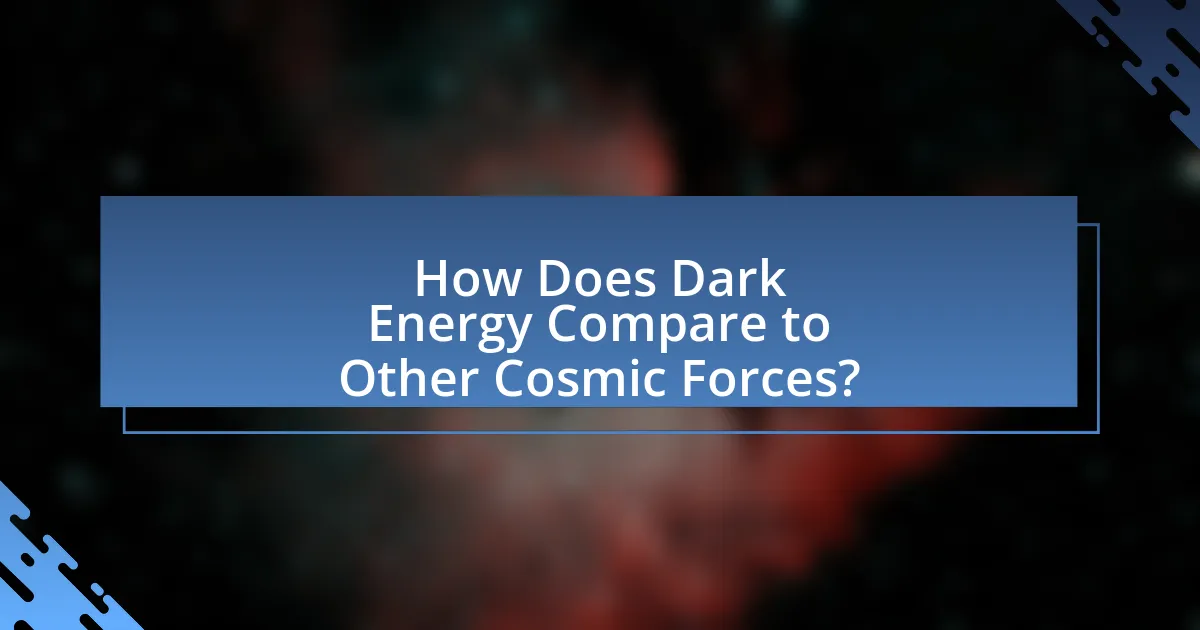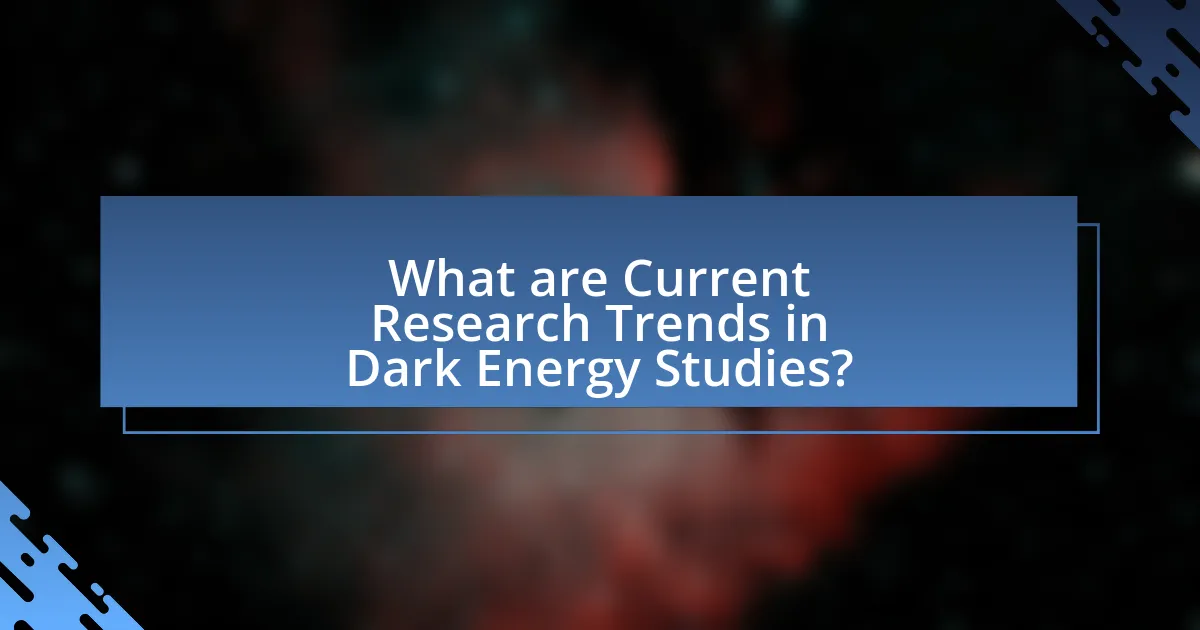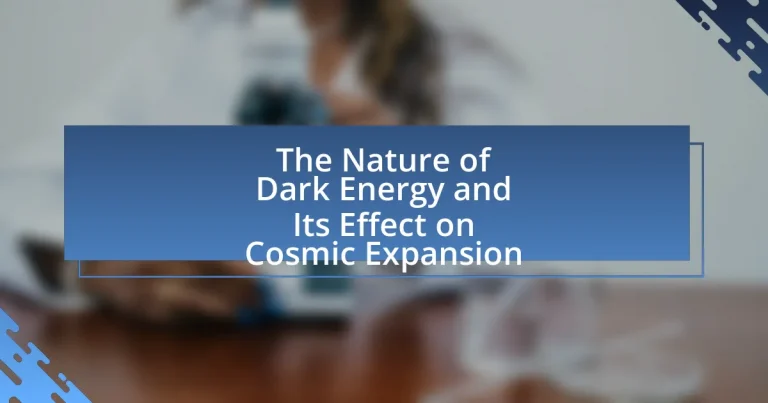Dark energy is a mysterious form of energy that constitutes approximately 68% of the universe and is responsible for its accelerated expansion. Discovered through observations of distant Type Ia supernovae in 1998, dark energy challenges existing theories in physics and cosmology by counteracting gravitational forces. The article explores the discovery and measurement of dark energy, its theoretical foundations, and its implications for cosmic expansion and the future of the universe. It also discusses the differences between dark energy and dark matter, current research trends, and the challenges faced by scientists in understanding this enigmatic force.

What is Dark Energy and Its Role in the Universe?
Dark energy is a mysterious form of energy that makes up approximately 68% of the universe and is responsible for its accelerated expansion. This phenomenon was first observed in 1998 when astronomers discovered that distant supernovae were dimmer than expected, indicating that the universe’s expansion is not slowing down as previously thought, but rather speeding up. The existence of dark energy challenges our understanding of fundamental physics and cosmology, as it does not emit light or energy and cannot be directly observed. Its role in the universe is crucial, as it counteracts the gravitational forces of matter, leading to the current model of an expanding universe governed by the equations of general relativity.
How was Dark Energy Discovered?
Dark energy was discovered through observations of distant supernovae, specifically the Type Ia supernovae, which revealed that the universe’s expansion is accelerating. In 1998, two independent research teams, the Supernova Cosmology Project and the High-Z Supernova Search Team, analyzed the light from these supernovae and found that they were dimmer than expected, indicating that the universe was expanding at an increasing rate. This unexpected acceleration led to the conclusion that a mysterious force, termed dark energy, constitutes about 68% of the universe, counteracting gravitational attraction and driving the accelerated expansion.
What observations led to the identification of Dark Energy?
The identification of Dark Energy was primarily led by observations of distant supernovae, specifically Type Ia supernovae, which revealed that the universe’s expansion is accelerating. This acceleration was unexpected, as it contradicted the prior assumption that gravity would slow the expansion over time. The key evidence came from the 1998 observations by the Supernova Cosmology Project and the High-Z Supernova Search Team, which measured the brightness and redshift of these supernovae, indicating that they were farther away than predicted by a decelerating universe model. This finding suggested the presence of an unknown force, later termed Dark Energy, which is driving the accelerated expansion of the universe.
How do scientists measure Dark Energy’s effects?
Scientists measure Dark Energy’s effects primarily through observations of distant supernovae, cosmic microwave background radiation, and large-scale structure of the universe. Observations of Type Ia supernovae reveal that these celestial events are dimmer than expected, indicating an accelerated expansion of the universe, which is attributed to Dark Energy. Additionally, measurements of the cosmic microwave background radiation provide insights into the universe’s expansion history and the influence of Dark Energy on its geometry. The distribution of galaxies and galaxy clusters also helps in understanding how Dark Energy affects cosmic structure formation, as it influences the rate at which these structures evolve over time. These methods collectively support the existence and effects of Dark Energy in the universe.
What are the Theoretical Foundations of Dark Energy?
The theoretical foundations of dark energy primarily stem from the cosmological constant introduced by Albert Einstein in 1917, which represents a form of energy density filling space homogeneously. This concept was later revived in the late 1990s when observations of distant supernovae indicated that the universe’s expansion is accelerating, suggesting the presence of an unknown energy component. The Lambda Cold Dark Matter (ΛCDM) model incorporates dark energy as a cosmological constant (Λ), which accounts for approximately 68% of the total energy content of the universe. This model is supported by various observational data, including the Cosmic Microwave Background radiation measurements from the Wilkinson Microwave Anisotropy Probe (WMAP) and the Planck satellite, which confirm the accelerated expansion and the universe’s flat geometry.
What are the leading theories explaining Dark Energy?
The leading theories explaining Dark Energy include the Cosmological Constant, Quintessence, and Modified Gravity. The Cosmological Constant, proposed by Albert Einstein, suggests that a constant energy density fills space homogeneously, driving the accelerated expansion of the universe. Quintessence posits that Dark Energy is a dynamic field that evolves over time, differing from the static nature of the Cosmological Constant. Modified Gravity theories, such as f(R) gravity, propose alterations to General Relativity to account for the observed acceleration without invoking Dark Energy. These theories are supported by observational evidence, including measurements of cosmic microwave background radiation and supernovae, which indicate an accelerating universe.
How does Dark Energy relate to the cosmological constant?
Dark energy is directly associated with the cosmological constant, which is a term introduced by Albert Einstein in his equations of general relativity to account for a constant energy density filling space homogeneously. The cosmological constant represents a form of dark energy that drives the accelerated expansion of the universe, as evidenced by observations of distant supernovae and the cosmic microwave background radiation. This relationship is crucial in cosmology, as it helps explain the observed acceleration of cosmic expansion, with current estimates suggesting that dark energy constitutes about 68% of the total energy density of the universe.
What Impact Does Dark Energy Have on Cosmic Expansion?
Dark energy accelerates the expansion of the universe. This mysterious form of energy constitutes approximately 68% of the total energy density of the universe and exerts a negative pressure that drives galaxies apart at an increasing rate. Observations, such as those from the Supernova Cosmology Project and the Wilkinson Microwave Anisotropy Probe, provide evidence that the universe’s expansion is not only continuing but accelerating, a phenomenon attributed to dark energy. The discovery of this acceleration in the late 1990s fundamentally changed our understanding of cosmology, indicating that dark energy plays a crucial role in shaping the universe’s fate.
How does Dark Energy influence the rate of expansion of the universe?
Dark energy accelerates the rate of expansion of the universe by exerting a negative pressure that counteracts gravitational attraction. This phenomenon was first observed through the study of distant supernovae, which revealed that the universe’s expansion is not only ongoing but is also accelerating. The discovery, published in 1998 by the Supernova Cosmology Project and the High-Z Supernova Search Team, demonstrated that the universe’s expansion rate is influenced significantly by dark energy, which constitutes approximately 68% of the total energy density of the cosmos. This acceleration implies that galaxies are moving away from each other at an increasing rate, fundamentally altering our understanding of cosmic dynamics.
What evidence supports the role of Dark Energy in cosmic acceleration?
The evidence supporting the role of Dark Energy in cosmic acceleration primarily comes from observations of distant supernovae, specifically Type Ia supernovae, which indicate that the universe is expanding at an accelerating rate. The Supernova Cosmology Project and the High-Z Supernova Search Team independently discovered that the brightness of these supernovae was dimmer than expected, suggesting that they are farther away than previously thought, which implies an accelerated expansion of the universe. Additionally, measurements of the cosmic microwave background radiation, particularly from the Wilkinson Microwave Anisotropy Probe (WMAP) and the Planck satellite, provide strong evidence for a flat universe that is dominated by Dark Energy, accounting for approximately 68% of the total energy density. Furthermore, large-scale structure observations, such as galaxy clustering and baryon acoustic oscillations, corroborate the presence of Dark Energy by showing how its effects influence the growth of cosmic structures over time.

How Does Dark Energy Compare to Other Cosmic Forces?
Dark energy is a dominant force in the universe, accounting for approximately 68% of its total energy density, significantly surpassing other cosmic forces such as dark matter and ordinary matter. While dark matter, which constitutes about 27% of the universe, exerts gravitational attraction, dark energy drives the accelerated expansion of the universe, acting in opposition to gravity. This distinction is crucial; for instance, observations from the Hubble Space Telescope and studies of Type Ia supernovae have shown that the universe’s expansion is not only ongoing but accelerating due to dark energy, a phenomenon not attributed to other cosmic forces.
What are the differences between Dark Energy and Dark Matter?
Dark Energy and Dark Matter are fundamentally different components of the universe. Dark Energy is a mysterious force that drives the accelerated expansion of the universe, accounting for approximately 68% of its total energy density, while Dark Matter, which constitutes about 27% of the universe, is a form of matter that does not emit light or energy, making it detectable only through its gravitational effects on visible matter.
The distinction lies in their roles: Dark Energy acts as a repulsive force, causing galaxies to move away from each other at an increasing rate, as evidenced by observations of distant supernovae and cosmic microwave background radiation. In contrast, Dark Matter contributes to the gravitational pull that holds galaxies and galaxy clusters together, as demonstrated by the rotation curves of galaxies and gravitational lensing effects.
How do Dark Energy and Dark Matter affect the universe differently?
Dark Energy and Dark Matter affect the universe differently by influencing its expansion and structure. Dark Energy is responsible for the accelerated expansion of the universe, making up approximately 68% of the universe’s total energy density, as evidenced by observations of distant supernovae and the cosmic microwave background radiation. In contrast, Dark Matter, which constitutes about 27% of the universe, contributes to the gravitational attraction that holds galaxies and galaxy clusters together, as demonstrated by the rotation curves of galaxies and gravitational lensing effects. Thus, while Dark Energy drives the universe’s expansion, Dark Matter shapes its structure.
What roles do gravity and Dark Energy play in cosmic structure formation?
Gravity plays a crucial role in cosmic structure formation by attracting matter together, leading to the formation of galaxies, stars, and larger structures like galaxy clusters. As matter clumps under the influence of gravity, it creates regions of higher density, which further attract more matter, facilitating the hierarchical structure formation observed in the universe.
Dark Energy, on the other hand, acts as a repulsive force that accelerates the expansion of the universe. This expansion counteracts the gravitational attraction between structures, influencing their growth and distribution. Observations, such as those from the Supernova Cosmology Project, indicate that approximately 68% of the universe’s energy density is attributed to Dark Energy, which affects how structures evolve over time by driving them apart.
Together, gravity and Dark Energy shape the large-scale structure of the universe, with gravity promoting the formation of structures and Dark Energy influencing their separation and expansion.
What are the Implications of Dark Energy for the Future of the Universe?
Dark energy is expected to drive the accelerated expansion of the universe, leading to significant implications for its future. As dark energy constitutes approximately 68% of the universe, its repulsive force will continue to dominate over gravitational attraction, causing galaxies to move away from each other at an increasing rate. This phenomenon suggests a future where galaxies become isolated, and the observable universe shrinks as distant galaxies recede beyond the cosmic horizon, rendering them unobservable. Observations from the Supernova Cosmology Project and the Wilkinson Microwave Anisotropy Probe support this understanding, indicating that the universe’s expansion is not only accelerating but will likely lead to a “Big Freeze,” where stars exhaust their nuclear fuel and galaxies fade into darkness over trillions of years.
How might Dark Energy influence the ultimate fate of the universe?
Dark Energy is believed to drive the accelerated expansion of the universe, significantly influencing its ultimate fate. This mysterious force constitutes approximately 68% of the universe and acts against gravitational attraction, causing galaxies to move away from each other at an increasing rate. Observations, such as those from Type Ia supernovae, indicate that this acceleration has been occurring for billions of years, suggesting that if Dark Energy continues to dominate, the universe may end in a “Big Freeze,” where galaxies drift apart, stars burn out, and the universe becomes increasingly cold and dark.
What scenarios are proposed for the long-term effects of Dark Energy?
The long-term effects of Dark Energy are primarily proposed to lead to scenarios such as the Big Freeze, Big Rip, and Heat Death of the universe. The Big Freeze suggests that as Dark Energy continues to drive the accelerated expansion of the universe, galaxies will move away from each other, leading to a cold, dark, and empty universe over trillions of years. The Big Rip scenario posits that if Dark Energy’s repulsive force increases over time, it could eventually tear apart galaxies, stars, and even atomic structures. Lastly, the Heat Death scenario indicates that the universe will reach a state of maximum entropy, where all energy is uniformly distributed, resulting in a lifeless, static cosmos. These scenarios are supported by observations of cosmic microwave background radiation and the distribution of galaxies, which indicate the influence of Dark Energy on the universe’s expansion rate.

What are Current Research Trends in Dark Energy Studies?
Current research trends in dark energy studies focus on understanding its nature and effects on cosmic expansion through various observational and theoretical approaches. One significant trend involves the use of large-scale surveys, such as the Dark Energy Survey (DES) and the upcoming Vera C. Rubin Observatory, which aim to map the distribution of galaxies and measure cosmic expansion with high precision. Additionally, researchers are exploring the implications of modified gravity theories and their potential to explain dark energy phenomena, as seen in studies like those published in the journal “Physical Review D.” Furthermore, advancements in gravitational wave astronomy are being investigated for their ability to provide insights into the properties of dark energy, as highlighted in recent works by the LIGO and Virgo collaborations. These trends reflect a multidisciplinary effort to unravel the complexities of dark energy and its role in the universe’s accelerated expansion.
What experiments are currently being conducted to study Dark Energy?
Current experiments studying Dark Energy include the Dark Energy Survey (DES), the European Space Agency’s Euclid mission, and the Vera C. Rubin Observatory’s Legacy Survey of Space and Time (LSST). The Dark Energy Survey, which began in 2013, utilizes a 570-megapixel camera to map the distribution of galaxies and measure their redshifts, providing insights into the effects of Dark Energy on cosmic expansion. The Euclid mission, set to launch in 2023, aims to explore the geometry of the dark universe by measuring the accelerated expansion of the universe through galaxy clustering and weak gravitational lensing. The LSST, expected to commence operations in the early 2020s, will conduct a ten-year survey of the sky, capturing data on billions of galaxies to further investigate the nature of Dark Energy. These experiments collectively aim to enhance our understanding of Dark Energy’s role in the universe’s expansion.
How do upcoming telescopes and missions aim to enhance our understanding of Dark Energy?
Upcoming telescopes and missions, such as the James Webb Space Telescope and the Euclid mission, aim to enhance our understanding of Dark Energy by providing high-resolution observations of distant galaxies and cosmic structures. These instruments will measure the expansion rate of the universe with unprecedented precision, allowing scientists to analyze the distribution of galaxies and the effects of Dark Energy on cosmic evolution. For instance, Euclid will map the geometry of the dark universe by observing billions of galaxies, which will help in constraining the properties of Dark Energy and its role in accelerating cosmic expansion. This data will be crucial for testing various cosmological models and understanding the fundamental nature of Dark Energy.
What role do simulations play in Dark Energy research?
Simulations play a crucial role in Dark Energy research by allowing scientists to model the universe’s expansion and the effects of Dark Energy on cosmic structures. These computational models help researchers understand how Dark Energy influences the rate of expansion and the formation of galaxies over time. For instance, simulations like the Millennium Simulation have provided insights into the large-scale structure of the universe, demonstrating how Dark Energy affects gravitational interactions and cosmic evolution. By comparing simulation outcomes with observational data from telescopes, researchers can refine their understanding of Dark Energy’s properties and its contribution to the universe’s overall dynamics.
What Challenges Do Scientists Face in Understanding Dark Energy?
Scientists face significant challenges in understanding dark energy primarily due to its elusive nature and the lack of direct observational evidence. Dark energy is theorized to make up approximately 68% of the universe, yet its properties remain largely unknown, complicating efforts to study it. The primary challenge lies in distinguishing dark energy from other potential explanations for cosmic acceleration, such as modifications to general relativity or the influence of other forms of energy. Additionally, the precise mechanism behind dark energy is still a matter of debate, with various models proposed, including the cosmological constant and dynamic fields. The difficulty in obtaining accurate measurements of cosmic expansion, particularly at great distances, further complicates the understanding of dark energy’s role in the universe.
What are the main uncertainties surrounding Dark Energy?
The main uncertainties surrounding Dark Energy include its exact nature, the reason for its accelerated expansion of the universe, and whether it is a constant force or varies over time. Current models, such as the cosmological constant, suggest Dark Energy is a form of energy inherent to space itself, but observational data from supernovae and cosmic microwave background radiation indicate inconsistencies that challenge this view. Additionally, the lack of a definitive theoretical framework to explain Dark Energy leads to various hypotheses, including quintessence and modified gravity theories, which further complicate our understanding. These uncertainties are critical as they impact the fate of the universe and our comprehension of fundamental physics.
How do differing interpretations of data complicate Dark Energy research?
Differing interpretations of data complicate Dark Energy research by leading to inconsistent conclusions about its properties and effects on cosmic expansion. For instance, various observational data, such as measurements from Type Ia supernovae and cosmic microwave background radiation, can be interpreted in multiple ways, resulting in different models of Dark Energy. These models may suggest varying rates of cosmic acceleration, which creates confusion in the scientific community. A notable example is the tension between measurements from the Planck satellite and those from local distance ladder methods, which yield different values for the Hubble constant, indicating a potential discrepancy in understanding Dark Energy’s role in the universe’s expansion. This inconsistency hampers the development of a unified theory and complicates efforts to validate or refute existing models.
What Practical Insights Can We Gain from Dark Energy Research?
Dark energy research provides practical insights into the accelerated expansion of the universe, which can influence future technologies and cosmological models. Understanding dark energy helps refine our knowledge of fundamental physics, potentially leading to advancements in energy generation and storage, as it challenges existing theories of gravity and energy. For instance, the discovery of dark energy in 1998 by the Supernova Cosmology Project and the High-Z Supernova Search Team revealed that the universe’s expansion is accelerating, prompting new approaches in theoretical physics and cosmology. This knowledge can inform the development of new materials and technologies that harness energy more efficiently, as researchers explore the implications of dark energy on the fabric of spacetime.
How can understanding Dark Energy inform our view of the universe?
Understanding dark energy reveals that it constitutes approximately 68% of the universe, influencing its accelerated expansion. This insight reshapes our comprehension of cosmic dynamics, suggesting that the universe’s fate is driven by this mysterious force rather than just matter and radiation. Observations from the Hubble Space Telescope and studies like the Supernova Cosmology Project have shown that distant supernovae are receding faster than expected, indicating the presence of dark energy. Consequently, recognizing dark energy is crucial for predicting the long-term evolution of the universe and understanding fundamental questions about its structure and ultimate fate.
What lessons can be applied from Dark Energy studies to other fields of science?
Dark Energy studies provide valuable lessons in understanding the role of unseen forces in various scientific fields. For instance, the concept of dark energy, which constitutes approximately 68% of the universe and drives its accelerated expansion, emphasizes the importance of considering unknown variables in scientific models. This principle can be applied to fields such as climate science, where unaccounted factors like feedback loops can significantly alter predictions. Additionally, the methodologies used in dark energy research, such as observational techniques and statistical analysis, can enhance data interpretation in fields like epidemiology, where understanding complex interactions is crucial. The application of these lessons fosters a more comprehensive approach to scientific inquiry across disciplines.

